It's Valentine's Day! Florists and retailers are still in the middle of the rush. The response of the end consumer and, therefore, the results of Valentine's Day 2024 will be evident after today, so this article provides an overview of the run-up to this holiday from different parts of the world. In short, we hear that it has been a pleasing holiday for many, that the demand on the free market or auction clock started quite late, that there was a lack of red roses at certain moments, and that the weather and logistics in some countries caused several challenges. And with Valentine's Day falling on a Wednesday, expectations are high as sales are usually higher on a weekday when compared to a holiday.

At the Dutch supermarket Albert Heijn, red roses at 7.99 or 5.99 euro per stem.
Netherlands
At the auction clock at Royal FloraHolland, the purchase peak was on Friday. However, the highest prices were registered at the last minute yesterday. Due to different reasons, the demand increased quite late, and the pricing fluctuated, with some outliers. There was a shortage of red, explains auctioneer Edwin Chrispijn. But in the end, they seem to be satisfied with this year's results.
The majority of the roses on the clock come from Africa, Latin America, and other countries. The Netherlands used to be one of the major rose growers in the world but now only has 130 ha of rose cultivation under light. Of the 150 million stems traded on the RFH clocks, only 16% is grown in the Netherlands. Annually, 3.2 billion roses are being sold via Royal FloraHolland.

The team of PJ Dave Flora Limited at the IFTF 2023 in Vijfhuizen, the Netherlands.
Kenya
In Kenya, the weather seems to have been the main challenge this year. "This year in first week of January weather in Kenya was not good, it was rainy and humid. So, all growers were worried about Valentine's flush. But, fortunately, the weather improved from the second week of January, and there were no quality issues for the Valentine's sale", says Santosh Kulkarni, Managing Director at PJ Dave Flora, the largest grower of the Rhodos rose. They sold 65% of their Rhodos flowers directly and 35% on the clock. In general, he was pleased with the sales but noticed that the clock prices were lower than in 2023. The reason? "Maybe because of an oversupply of red roses to the clock and the economic situation of Europe.
Also, Andrew Wambua of Mzurrie Flowers, who only sells its roses directly, told us about the weather challenges in an interview last week. He also mentioned that he noticed an increase in demand for colored roses and mixed bouquets and that they expected the airfreight capacity to be a challenge but that the freighters brought extra capacity, which mitigated capacity issues.
India
Also, in India, growers were dealing with some challenges, particularly with airspace and airfreight, which shot up quite high during the Valentine's period, Dolly Mahawar of Indian rose farm Soex Flora tells us. "Due to ongoing disruptions in the Red Sea route, the logistics costs were pushed up immensely, as several volume cargoes were diverted from sea route to air, which was leading to space constraints and higher air freight charges, especially for Middle Eastern countries otherwise, we could have done some more volumes." But overall, she reports satisfactory sales during Valentine's. "Also, clients were happy with the quality we supplied, and we managed to have on-time deliveries."
Latin America
Also, in the other large flower-producing countries, namely Colombia and Ecuador, they had to deal with several challenges. Unlike Kenya, of where most flowers go to Europe, many of their flowers go to the United States for this holiday. According to Jorge Ortega of Matina Flowers, a Colombian rose farm, expectations were very high for this year's Valentine's Day. "Many farms in Colombia and Ecuador were eager to have a successful season in order to recover from the awful second semester of sales in 2023", he says. But Valentine's Day is always a season full of challenges, he continues.
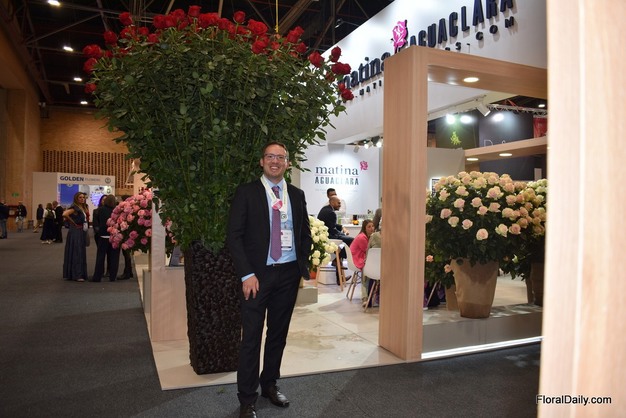
Jorge Ortega of Matina Flowers is in front of 2.5 meters of Freedom at the Proflora 2023 in Bogota, Colombia.
Colombia
When looking at production in Colombia, the first challenge, as usual, says Ortega, was the weather. We experienced a very dry and sunny season before Valentine's Day, so the risk of frost was constant. This also prompted several farms to begin their V-day production earlier. This, in turn, produced a domino effect because farms had to sell the product weeks before the actual shipping weeks at lower prices to try to move inventory. This created the perception among customers that there were many flowers in the market, affecting both prices and pre-books due to the lack of scarcity effect. By the way, in my opinion, this effect diminishes every year due to the oversupply of roses that we are experiencing, something that rose growers will need to learn to deal with."
"Another factor that did not help the season at all was that many airlines started charging V-day freight prices from the start of week 3. As a result, many customers weren’t able to buy additional boxes for the whole week due to the high cost of freight, which did not allow farms with earlier productions to move the product. Customers simply can’t afford V-day freight prices for flowers that will not be sold at V-day prices."
At the end of the day, with all the struggles that come with the season, it was a good season for most of the farms, he concludes. "Valentine's Day is and will be a love it or hated season, or both in my case. And also will always be the most important season for rose producers because it contributes a significant percentage to the annual billing of the farms and the flower business in general."
During the Valentine´s Day season, Colombian flower growers generate 27,000 additional direct jobs, bringing forth a significant contribution to Colombian labor life, Asocolflores reports. The most exported variety for this holiday is the rose, red roses mainly, which represent around 90% of the total exports.
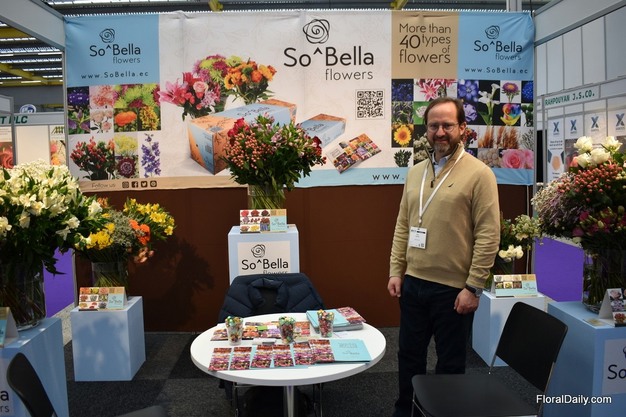
Boris Mantilla at the IFTF 2023.
Ecuador
Also, in Ecuador, the Valentine's Day season seems to have been a satisfying one. Valentin's season has been quite positive in Ecuador but did not go without any challenges. "I see the entire value chain satisfied with the results although there were inconveniences, especially concerning the weather that in the end didn't affect the results," says Boris Mantilla of SoBella Flowers, a broker company.
"Since this year, SoBella has resumed sales from Colombia, but if we compare it with what happened in Ecuador, there is an important contrast because in Colombia, there was an unusual amount of sun and clear skies that caused flowers to bloom too early, but in some cases, the flower also suffered damage due to excessive sunlight, then the weather changed, and they had pests problems such as botrytis. In part, this contributed to intensifying the sales in Ecuador and compensating for the decline in Colombia."

The team of Agrivaldani
Also, Daniela Lobato of Agrivaldani, a rose farm that shipped most of its flowers to Europe and the US this year, mentioned that the weather caused a challenge. "We are thankful the weather was better than usual, however since it was extremely warm, there was a lot of availability in the market. During open market sales, there were moments when we felt that the market was a little saturated. We did feel nervous that sales were going to go down, but as the day progressed, our amazing clients would bring in more orders."
And Nicholas Chang, VP of Sales & Marketing at Rosaprima shared that all orders were fulfilled promptly and flawlessly. "That highlighting our efficient operations and commitment to excellence. Valentine's Day at Rosaprima was truly gratifying, not only due to the positive response but also in witnessing the happiness we helped create for our partner distributers and ultimately florists around the world."
According to Mantilla, going further in the season, there was a shortage of reds, but fortunately, all orders could be fulfilled and were larger than expected. "At the beginning of the season, there were also a lot of flowers in Ecuador, but most of it was sent by sea transport. In the following weeks in Ecuador, there were enough flowers with a shortage of red roses." And when talking about shipping flowers via ocean, more flowers are increasingly being shipped via ocean vessels. PortMiami reports that approximately 76 million stems moved through PortMiami during this Valentine’s Day season (2024, from February 1-13), which is nearly 2.5 million stems more than in the same period in 2023. "The majority of the stems come from Colombia (44%) with 27% coming from Guatemala and 24% from Ecuador," More on the increasing popularity of ocean shipments, later on FloralDaily.
Logistics also suffered setbacks, he continues. "KLM announced a pilot strike, some flights were canceled, many charter flights that came from Asia making a stopover in Anchorage, Alaska were trapped by the snowfall, causing delays, which generated congestion of flower boxes in Quito that could be solved thanks to the expansions that have been made in the infrastructure of the airport, the cargo agencies new charters. Most of the clients didn't realize about this problem."
And for Agrivaldani’s creative department, it was a big season. "We came up with new and interesting Art Studio Collections, which were a big hit among our clients. We also launched our What is Love? - a campaign to celebrate the different types of love that there are while showcasing our beautiful products and awesome squad."
North America
In the US, where the majority of the flowers are imported from Latin America, sales have been pleasing for the trade too. Joost Bongaerts of Florabondunce in California told us earlier this week that many wholesalers were pleased and satisfied with the results so far and that having Valentine’s Day fall on a Wednesday seems to make things smoother. And Lawrence Hopman of Hopman Limited, a floral consulting agency that connects primary growers directly to mass retailers, adds that it also helps that it is falling on a working weekday as the demand for flowers is higher versus weekends when people opt to split their Valentine's spend on dinners and themed events.
And Hopman, who is based in Canada, also reports a strong demand from retailers in North America this year and even feels that this was one of the best demand years that he has ever seen since pre-covid. However, also here, the run-up did not go without any challenges. "Our northern cut flower and blooming producers experienced some crop delays due to low light levels coming out of January. While temperatures have been quite high, resulting in savings on heating costs, PPFD levels were low, causing some crops to miss their target weeks. They will need to ship in the low-demand weeks following the holiday. Not great for the growers, but there will be some excellent opportunities for some sharp and nimble category managers to grab some extra margin or pass on some deals to their consumers. Flowers from South America and Asia, however, shipped without any issues."
According to Hopman, fresh-cut roses are the best sellers, but potted roses did well too. And Bill Prescott of Sun Valley Farms in California told us in an interview last week that tulip, lily, and iris sales were strong.
And Hopman says that consumers are also seeing more value in mixed bouquets and consumer bunches as well as value-added potted plants and dish garden products. "The days of clear sleeves and speed covers are over as the demand was high for upgraded packaging for both cut flowers and potted plants. A good development for growers as thoughtful upgrading improves their bottom line and pushes up sell-thru for retailers, not just at Valentine's Day, but year-round."
And the expectations in the continent for today are good too. Hopman: "The weather forecasts were good across the continent, which will result in strong brick & mortar store sales."
United Kingdom
In the UK, Valentine's Day, however, doesn't seem to look so rosy. One of the leading wholesalers at New Covent Garden Market said this morning that Valentine’s Day trade had not met with expectations this year due to the spiraling cost of living in the UK. “It’s certainly not been as buoyant as usual,” says Graeme Diplock, Managing Director of Green & Bloom Flowers, at New Covent Garden Flower Market. “It’s busy, without a doubt, but it just feels about 75% of what we’d expect it to be.”

Graeme Diplock
The main post-Brexit challenges to date have been the increasing administrative burden on small companies, sporadic delays, and additional costs, which, of course, when combined with increasing operational costs generally, leads to higher prices. The impact of additional post-Brexit border checks is something that concerns the flower market’s traders, but it hasn't really kicked in yet. The new Border Target Operating Model is very likely to cause some unwanted, unpredictable, and what they see as unnecessary delays as it gets rolled out, and obviously, that could prove to be disruptive to trade.
But, media reports that the market is short and prices are skyrocketing are wide of the mark, though. “Prices are definitely strong – the Dutch market has kept them high – but there is no shortage of product at all,” says Graeme. “The retailers and customers don’t see that impact anyway; we’ll be the ones who are affected when a product doesn’t turn up on time.
“The only thing we’re a bit short of is customers. Roses are, of course, still selling more than anything else, but the drop-off in demand has been for every product. It’s the same across the market, and I can only put it down to the rising cost of living. Everything, not just flowers, costs more at the moment, and people are nervous about spending.
“So while Valentine’s Day trade has been OK, it hasn’t been putting the icing on the cake, which is what we really like it to do.”
More from New Covent Garden:
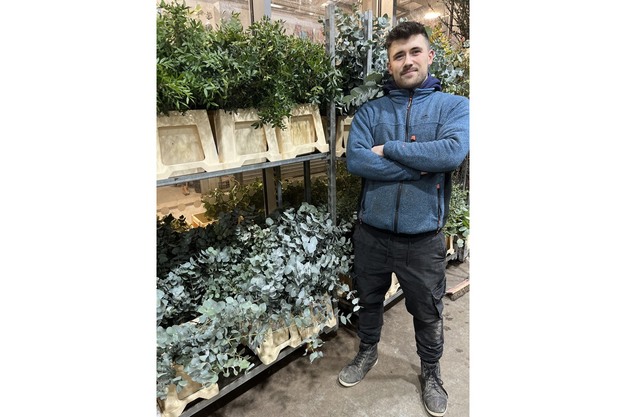
Valentine’s Day is not just about roses – at Porters Foliage, the team sold large quantities of Italian eucalyptus and Spanish pistachio, which are popular fillers for bouquets on the annual day of love. Supply was good this year and prices were in the region of £5 for a bunch of eucalyptus and £2.50 a bunch for pistachio. The firm was also advising customers that nandina, otherwise known as Sacred bamboo, is perfect for Valentine’s Day bunches. Josh Souter of Porters is pictured with some of the earlier high-quality products.
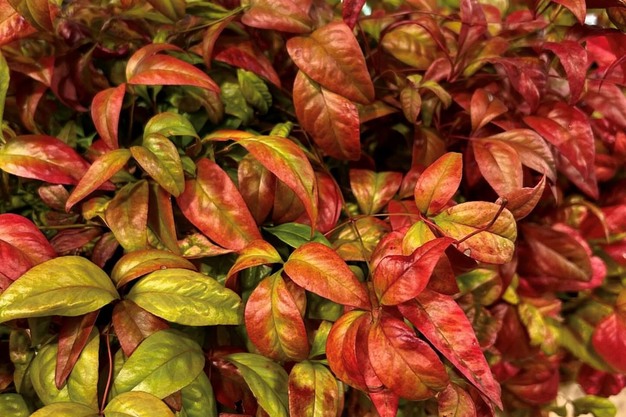
Sacred Bamboo
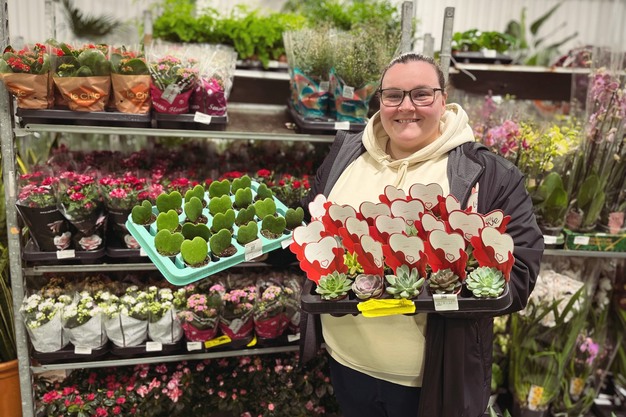
Brogan McGuinness of Green & Bloom Plants sold a nice volume of Hoya Kerrii, a heart-shaped succulent also known as Love Heart Plant and Lil’ Sweetheart, in the run-up to February 14. Trade of the love-struck plant were steady over the last two weeks, she reported, both in the market and online. Sales have also been good of the succulent pots Brogan is modelling (right) resplendent with love heart calling cards in each pot. Orchids have also been a good seller, particularly phalaenopsis and cymbidium - and the color purple has been flying off the shelves as a perennial Chinese New Year favorite.
 Valentine’s Day is a family affair for DG Wholesale Flowers Ltd. Owner Dave Gibbs (pictured) and his son James confirm that perennial favorite red roses were, of course, in high demand, but they’ve noticed subtle changes in color preferences from their customers year-on-year. “Although they are always popular, classic red roses have really come back into fashion this year, whereas the lighter shades of red have been favorites over the past two years or so,” said Dave. As you’d expect, Instagram really influences what’s in demand, so DG has a wide selection of stems to suit all tastes. “We also sold a lot of beautiful ranunculi for around £2.50 per stem,” Dave adds. “They are top of the range and grown in Italy. I’d recommend them to anyone who’s looking for something a little special this year.”
Valentine’s Day is a family affair for DG Wholesale Flowers Ltd. Owner Dave Gibbs (pictured) and his son James confirm that perennial favorite red roses were, of course, in high demand, but they’ve noticed subtle changes in color preferences from their customers year-on-year. “Although they are always popular, classic red roses have really come back into fashion this year, whereas the lighter shades of red have been favorites over the past two years or so,” said Dave. As you’d expect, Instagram really influences what’s in demand, so DG has a wide selection of stems to suit all tastes. “We also sold a lot of beautiful ranunculi for around £2.50 per stem,” Dave adds. “They are top of the range and grown in Italy. I’d recommend them to anyone who’s looking for something a little special this year.”
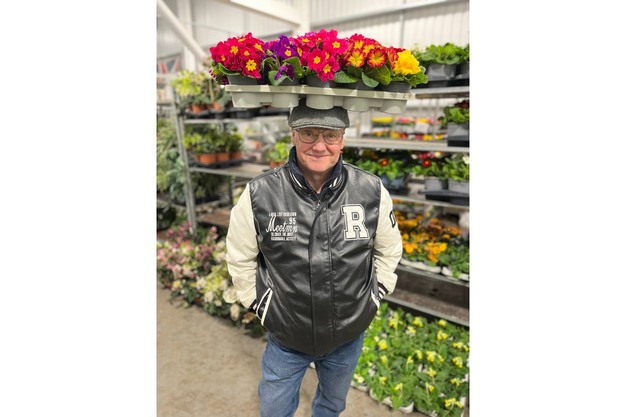 Bob Cooley at plant specialist L Mills quipped that “nothing says Valentine’s Day better than a box of marigolds.” Who are we to argue with a man with his skills!?
Bob Cooley at plant specialist L Mills quipped that “nothing says Valentine’s Day better than a box of marigolds.” Who are we to argue with a man with his skills!?
Poland
So, let's take a look at the Valentine's Day presentation at several supermarkets in Poland, where the entrance zones become red with hundreds of hearts. The day before Valentine's Day, Bohdan Tustanivskyi of Profiflora visited several supermarkets. He notices that the Valentine's Day area is becoming larger and more attractive every year. "Customers know that the retailers offer good quality products for stable prices. Usually, supermarkets don't raise the prices during events like Valentine's, Women's Day, and Mother's Day, and suppliers, due to the contracts, need to deliver more flowers at the same price. That's why it's a big and good chance for retailers' visitors to buy flowers in the "warm period" for a really good price."
"If customers want to buy something more floristic or, for example, long flowers (between 70-90 cm), they go to flower shops. The reason is the high costs for logistics as these flowers are delivered "on water."
When comparing Valentine's Day 2024 with previous years, he notices that two major things at Polish supermarkets: a very nice zone for decorations of cut flowers, and that supermarkets have started offering to buy something with the flowers, like "strawberry hearts," red muffins, sweets, small presents, red pillows and so on.
Below an impression
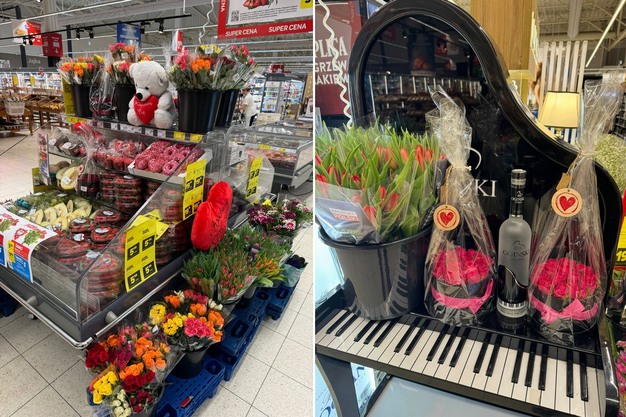
Carrefour
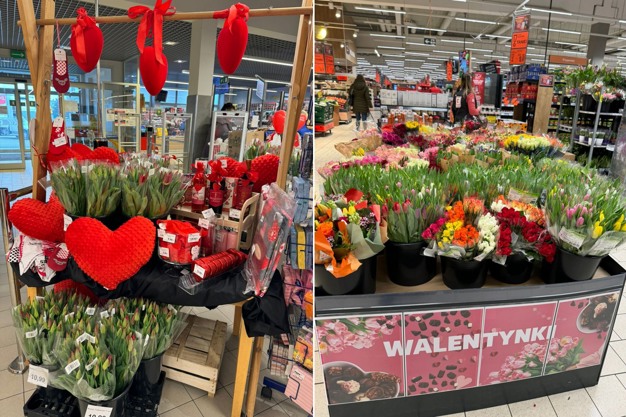
Spolem and Kaufland.
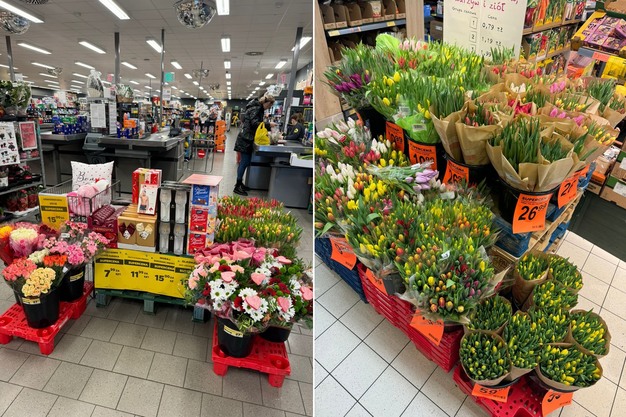
Netto and Biedronka
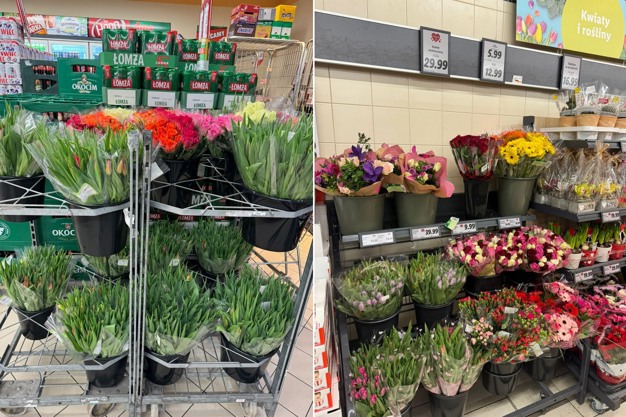
Dino and Lidl
